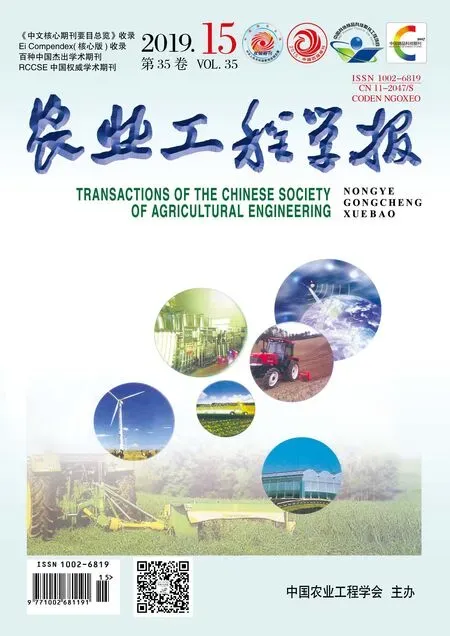气相温度脉动对非球形生物质颗粒焦炭燃烧的影响
李 捷,张 健
气相温度脉动对非球形生物质颗粒焦炭燃烧的影响
李 捷,张 健
(清华大学航天航空学院工程力学系,北京 100084)
将生物质颗粒与煤粉混合燃烧,可以有效地利用生物质能。生物质颗粒通常形状很不规则,有着较大的长径比,非球形特性较为明显。对于在燃烧室内运动与燃烧的生物质颗粒,气相湍流脉动是否会对非球形生物质颗粒的燃烧反应过程产生作用有待探讨。该文研究了气相温度脉动对热气流中非球形生物质颗粒瞬时焦炭燃烧的影响,给出了不同气相平均温度和颗粒长径比下生物质颗粒瞬时质量和瞬时焦炭燃烧速率随时间的变化。研究表明气相温度脉动对不同长径比的生物质颗粒的焦炭燃烧过程均有明显的影响,导致颗粒质量下降变快,焦炭燃尽时间变短。气相温度脉动幅度的增加进一步加快了不同长径比颗粒瞬时质量的下降。该文的研究揭示了气相温度的湍流脉动对非球形生物质颗粒瞬时焦炭燃烧过程的作用,这种作用并不会因为颗粒长径比的变化而发生改变。
生物质;燃烧;排放控制;非球形颗粒;焦炭;气相温度脉动
0 引 言
生物质能作为清洁的可再生能源,具有良好的经济、生态和社会效益。生物质的热化学转化,如生物质颗粒与煤粉的混合燃烧,不仅可以有效地利用生物质能,而且可以减少燃烧污染物和温室气体的排放[1-3]。
与煤粉混合燃烧的生物质颗粒在燃烧室内同时受到气相湍流、颗粒非球形性、颗粒化学反应、对流传热传质等多种因素的共同作用和制约[4]。生物质颗粒通常形状很不规则,有着较大的长径比,非球形特性较为明显。非球形性会影响颗粒的表面积和气相对颗粒的动量、能量和质量传递,因此生物质颗粒与球形颗粒的空气动力学和传热传质特性有较大的不同,这给对生物质颗粒运动、传热传质和燃烧的理论描述带来了难度。
另一方面,由于气相湍流燃烧的作用,与煤粉混燃的生物质颗粒在燃烧室内的运动与燃烧始终处于有速度和温度湍流脉动的热气流中。气相速度的湍流脉动对生物质颗粒的运动具有不容忽视的影响[5],而气相温度的脉动是否会对非球形生物质颗粒的焦炭燃烧过程产生影响则有待探讨。生物质颗粒与混燃的煤粉颗粒相比,除非球形状更为明显外,还有许多其他不同的性质,如尺寸相对较大、密度较低、反应活性较高等。因此,生物质颗粒对气相温度湍流脉动的瞬时响应与煤粉颗粒不同,生物质颗粒焦炭燃烧受气相温度脉动的作用也与煤粉颗粒不同。目前国内外在对燃烧室内生物质颗粒与煤粉混燃的数值模拟中,均未考虑到气相温度的湍流脉动对生物质颗粒焦炭燃烧的影响[6-9]。
生物质颗粒呈现出不同的非球形状,本文选取扁长椭球形状的颗粒[10]作为非球形生物质颗粒的代表。扁长椭球颗粒具有变化范围较大的长径比或球形度,其形状还可用作柱状颗粒的一种近似。通过求解颗粒的瞬时控制方程组,研究了在高温气流环境中不同的平均温度下,气相温度脉动对生物质颗粒焦炭燃烧的影响。
1 非球形生物质颗粒焦炭燃烧的瞬时控制方程组
假设生物质颗粒的水分和挥发分已经释放完毕,颗粒中仅包含焦炭和灰分。考虑气体-颗粒的对流传热、颗粒与燃烧室壁面的辐射传热以及焦炭燃烧放热反应,生物质颗粒的瞬时能量方程可写为

式中T为颗粒瞬时温度,K;m为颗粒瞬时质量,kg;C为颗粒比热,J/(kg·K);为时间,s;ck、rk和Q分别为气相对颗粒的对流传热量、燃烧室壁面对颗粒的辐射传热量及焦炭燃烧放热量,W。
考虑到生物质颗粒的椭球形状,颗粒瞬时质量可表示为
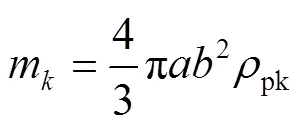
式中和分别为椭球颗粒的长半轴和短半轴尺寸,m;pk为颗粒材料密度,kg/m3。
气相对颗粒的对流传热量为


式中为气相导热系数,W/(m·K)。
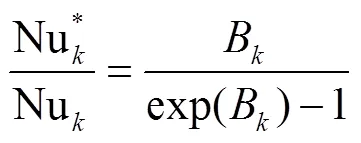
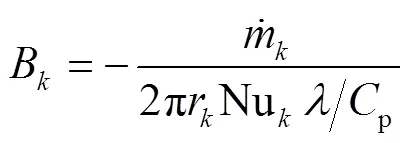


颗粒与燃烧室壁面的辐射传热量可以表示为

式中ε为颗粒表面发射率;σ为Stefan-Boltzmann常数,5.67´10-8W/(m2·K4)。
焦炭燃烧放热量可以表示为


按氧气向椭球颗粒表面扩散得到的焦炭氧化反应瞬时速率为

式中为焦炭氧化反应的化学当量比系数,此处仅考虑焦炭氧化反应生成CO的单一反应,即=1.332,ox,s和ox,∞分别为颗粒表面和环境中的氧气质量分数,和分别为气相密度(kg/m3)和组分扩散系数(m2/s),Sh为颗粒Sherwood数。考虑到颗粒的非球形性,上述各式中颗粒Nusselt数和Sherwood数的计算式分别取为[11]


式中Re为颗粒相对于气体运动的Reynolds数,按与颗粒等体积球的直径计算。Pr和Sc分别为气体的Prandtl数和Schmidt数,en为非球形颗粒增强因子。非球形增强因子可由关于颗粒长径比的代数式表示为[12-13]

式(12)与文献[14]和[11]得到的扁长椭球颗粒非球形增强因子的积分表达式是一致的,而代数表达式比积分表达式更便于应用。式(10)和(11)是将颗粒Nusselt数和Sherwood数分别表示成了球形颗粒Nusselt数和Sherwood数与非球形增强因子的乘积。
通过异相化学动力学得到的颗粒焦炭反应瞬时速率为[15]

式中s、s、ox、B、E和分别为颗粒表面的气体压力(Pa)与分子量(kg/mol)、氧气分子量(kg/mol)、焦炭反应指前因子(kg/(m2·s·Pa))与活化能(J/mol)和通用气体常数(J/(mol·K))。
将式(2)与式(6)~(8)代入式(1)中,得到颗粒的瞬时能量方程为

颗粒的瞬时质量方程为

设焦炭燃烧过程中,颗粒的材料密度不变,长径比=/也保持不变[16],得到颗粒的瞬时短半轴尺寸为

扁长椭球颗粒的瞬时表面积为

由式(17)可求出与颗粒等表面积球的瞬时半径。
将生物质颗粒置于瞬时温度空间分布均匀但随时间呈正弦方式脉动的热气流中,气相瞬时温度按式(18)给出

2 数值求解与工况参数
对颗粒瞬时控制方程组使用有限差分法进行离散,得到它们的差分方程,进而数值求解得到生物质颗粒瞬时温度、质量、尺寸和质量变化率等随时间变化的历程。采用一种草本生物质燃料(蓟)作为研究对象。其焦炭燃烧的指前因子与活化能分别为[15]:B=0.46 g/(m2·s·Pa),E=63 kJ/mol。工业分析成分为:水分12.26%,挥发分61.92%,固定碳19.25%,灰分6.57%。焦炭燃烧过程中颗粒材料密度、比热和表面发射率均为定值,分别取为[17]:pk=90.4 kg/m3,pk=1 600 J/(kg·K),ε=0.8。气相导热系数和比热通过经验关系式,由气相温度和组分浓度计算得到[18]。
此外,还计算并分析了松木颗粒的瞬时焦炭燃烧过程。松木颗粒瞬时焦炭反应的动力学速率为[19]

式中的动力学参数为:B=0.65Tm/s,E=63 kJ/mol;s为颗粒表面的气体密度,kg/m3。松木的工业分析成分为:水分12.38%,挥发分69.41%,固定碳17.40%,灰分0.81%。松木焦炭颗粒的材料密度为63.7 kg/m3。
为了考察气相温度脉动对生物质颗粒瞬时质量变化和瞬时焦炭燃烧速率的影响,对2种生物质颗粒的瞬时焦炭燃烧过程在不同的工况条件下进行了计算。计算中气相平均温度分别取为1 000和1 100 K。生物质颗粒焦炭反应的活性较强,在更高的气相平均温度下,气相温度脉动对生物质颗粒焦炭燃烧仍有影响,由于生物质焦炭颗粒的燃尽时间变短,这种影响会有所削弱。颗粒初始的等体积球直径取为200m,颗粒Reynolds数取为0,壁面温度和颗粒初始温度均取为300 K。数值求解的时间步长均取为10-5s。气相环境中的组分仅考虑氮气和氧气,它们的质量分数分别为0.9和0.1。气相温度脉动频率取为100 Hz,气相温度脉动幅度分别取为0、0.1和0.2,试验测得的燃烧室内气相温度脉动均方根值与气相平均温度之比为0.1~0.2[20]。文献[21]对生物质颗粒的形状进行了测量,得到扁长椭球颗粒的最大长径比为10。因此对草本生物质颗粒的长径比分别取为1.4、4和7,松木颗粒的长径比分别取为5和10。图1显示了扁长椭球颗粒在1.4、4和7共3种长径比下的初始形状。

注:M为生物质扁长椭球颗粒的长径比,下同。
3 结果与讨论
图2a给出气相温度脉动对长径比为1.4的草本生物质颗粒焦炭燃烧瞬时质量变化的影响。当气相平均温度为1 000 K时,在焦炭燃烧过程中,与不考虑气相温度脉动相比,考虑气相温度脉动的椭球颗粒瞬时质量的下降变快,焦炭燃尽时间变短。增大气相温度脉动幅度,颗粒瞬时质量的下降得到进一步加快,焦炭燃尽时间也得到进一步的缩短。当气相平均温度从1 000 K上升到1 100 K时,气相平均温度的提高显著地加快了颗粒瞬时质量的下降,缩短了焦炭燃尽时间。当气相平均温度为1 100 K时,气相温度脉动对长径比为1.4的生物质颗粒焦炭燃烧的瞬时质量变化仍有较明显的影响,气相温度脉动幅度的增大使颗粒瞬时质量的下降加快。但与气相平均温度为1 000 K时相比,气相温度脉动对颗粒瞬时质量下降和焦炭燃尽时间的影响有所减弱。
图2b给出了气相平均温度为1 000和1 100 K时,气相温度脉动对长径比为4的草本生物质颗粒焦炭燃烧瞬时质量变化的影响。由图2b可见,气相温度脉动导致长径比为4的颗粒的瞬时质量下降和焦炭燃尽时间明显变快。图2c分别给出了气相平均温度为1 000和1 100 K时,气相温度脉动对长径比为7的草本生物质颗粒焦炭燃烧瞬时质量变化的影响。尽管长径比增加较多,但颗粒瞬时质量的下降仍受到气相温度脉动的明显作用。气相温度脉动使颗粒质量下降变快和焦炭燃尽时间变短。
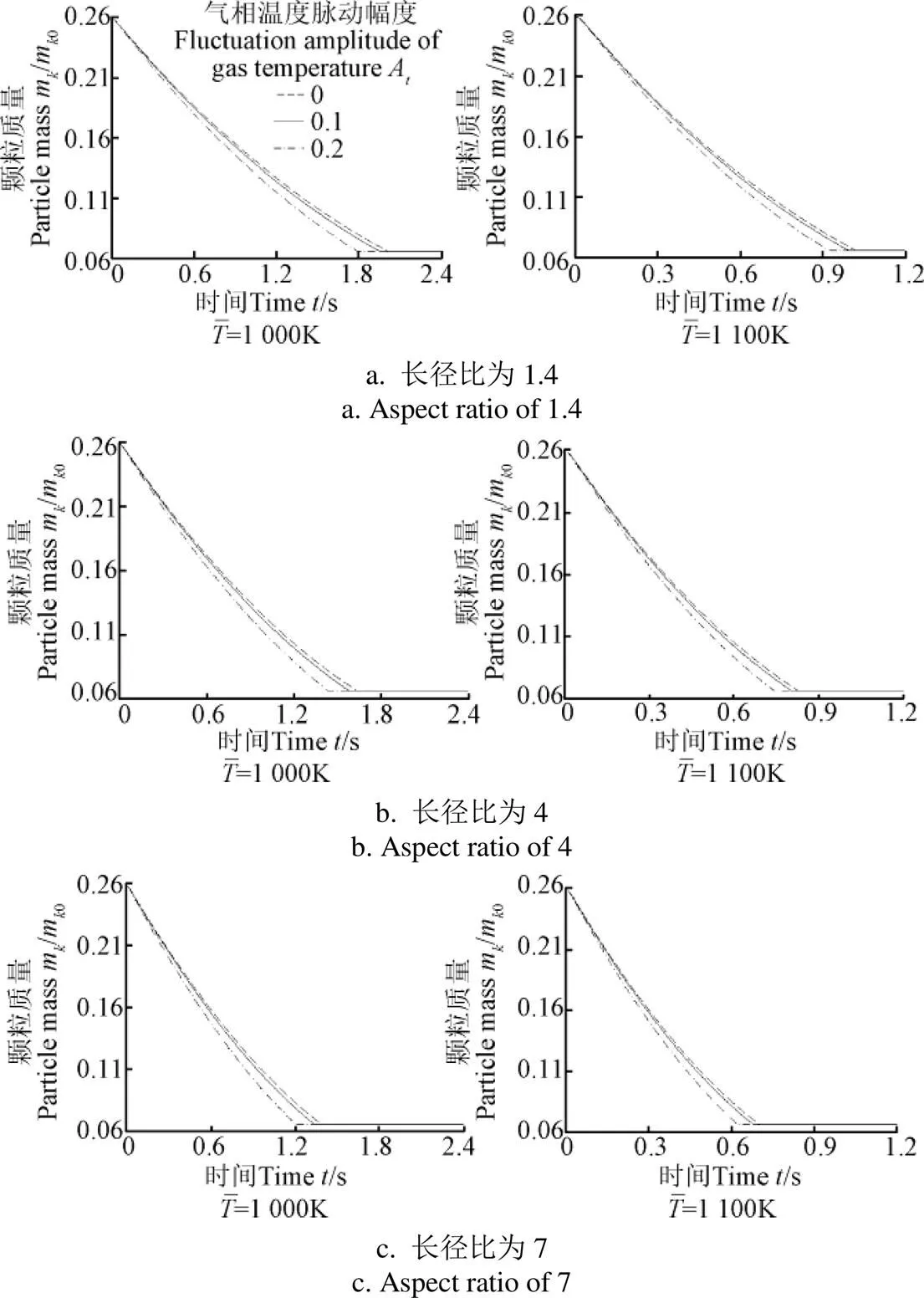
注:为气相平均温度,K,余同。mk0为生物质颗粒的原始质量,kg。
图3a给出气相温度脉动对长径比为1.4的草本生物质颗粒瞬时焦炭燃烧速率的影响。在气相平均温度为1 000和1 100 K时,不考虑气相温度脉动与考虑气相温度脉动得到的长径比为1.4的颗粒的瞬时焦炭燃烧速率有较大的差别。不考虑气相温度脉动时得到的颗粒瞬时焦炭燃烧速率随着反应的进行平稳地变化。而考虑气相温度脉动时得到的瞬时焦炭燃烧速率则随时间脉动式地变化,且随着气相温度脉动幅度的增加,脉动的幅度增大。这是因为气相温度脉动导致颗粒温度的脉动,而颗粒温度的脉动进一步影响到焦炭燃烧速率的变化。同时还可以看到,在焦炭燃烧过程中,由于焦炭燃烧反应动力学速率与颗粒温度之间的指数函数关系,与不考虑温度脉动时相比,考虑温度脉动时的焦炭燃烧速率峰值增加的幅度略大于谷值减少的幅度。而气相温度脉动幅度的增加进一步拉大了峰值增加幅度和谷值减少幅度的差距。因此,考虑气相温度脉动时要快于不考虑气相温度脉动时颗粒焦炭的质量损失,且气相温度脉动幅度越大,焦炭的质量损失越快。

图3 气相温度脉动对不同长径比的草本生物质颗粒瞬时焦炭燃烧速率的影响
图3b分别给出了气相平均温度为1 000和1 100 K时,气相温度脉动对长径比为4的草本生物质颗粒瞬时焦炭燃烧速率的影响。由图3b可见,受气相温度脉动的作用,长径比为4的颗粒的瞬时焦炭反应速率呈现出明显的脉动,且脉动幅度随气相温度脉动幅度的增加而增大。与不考虑气相温度脉动时相比,考虑气相温度脉动时的瞬时焦炭反应速率峰值增加的幅度超过了谷值减少的幅度。图3c分别给出了气相平均温度为1 000和1 100 K时,气相温度脉动对长径比为7的草本生物质颗粒瞬时焦炭燃烧速率的影响。长径比为7的颗粒瞬时焦炭燃烧速率依然受到气相温度脉动的显著影响,随时间脉动式地变化。考虑与不考虑气相温度脉动相比,瞬时焦炭燃烧速率峰值增加的幅度超过了谷值降低的幅度。
图4给出了气相平均温度为1 000 K时,气相温度脉动对长径比为5和10的松木颗粒焦炭燃烧过程中瞬时质量变化的影响。如图4a所示,长径比为5的松木颗粒的瞬时质量变化受到气相温度脉动的影响,气相温度脉动使颗粒瞬时质量下降得更快。气相温度脉动幅度的增大进一步加快了颗粒的质量损失。对比图4b与图4a可以看到,随着长径比的增大,具有相同初始等体积球直径颗粒的焦炭燃尽时间缩短。尽管如此,长径比为10的松木颗粒的瞬时质量变化也受到了气相温度脉动的影响,颗粒瞬时质量以比不考虑气相温度脉动时相对更快的速率下降。随气相温度脉动幅度增大,这一影响变得更加明显。
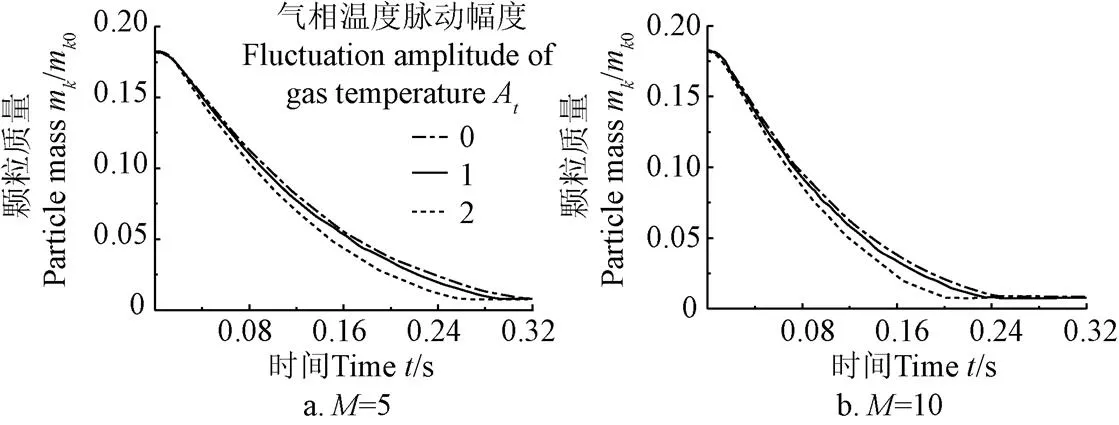
图4 气相温度脉动对不同长径比的松木颗粒焦炭燃烧瞬时质量变化的影响
4 结 论
本文考虑到生物质颗粒的非球形状,对颗粒在有温度脉动的热气流环境中的瞬时焦炭燃烧过程进行了计算,得到如下结论:
1)在不同气相平均温度下,气相温度脉动对生物质椭球颗粒的瞬时焦炭燃烧过程均有明显的影响,导致颗粒瞬时质量下降变快。气相温度脉动幅度的提高进一步加快颗粒瞬时质量的下降,进而减少焦炭燃尽时间。当气相平均温度升高时,气相温度脉动对颗粒瞬时质量下降和焦炭燃尽时间的影响有所减弱。
2)在长径比大于1的条件下,气相温度脉动对具有不同长径比或球形度的生物质颗粒的瞬时焦炭燃烧过程均有较明显的影响,加快了颗粒瞬时质量的下降和焦炭的燃尽。
3)不考虑气相温度脉动时不同长径比颗粒的焦炭燃烧速率随时间平稳地变化,而考虑气相温度脉动时颗粒的瞬时焦炭燃烧速率随时间脉动式地变化。随着气相温度脉动幅度的增加,焦炭燃烧速率脉动的幅度增大。
4)本文的研究揭示了气相温度的湍流脉动对非球形生物质颗粒瞬时焦炭燃烧过程的影响,在生物质与煤粉混燃的湍流多相燃烧理论模型中应当考虑到这一影响。
[1] Sami M, Annamalai K, Wooldridge M. Co-firing of coal and biomass fuel blends[J]. Progress in Energy and Combustion Science, 2001, 27(2): 171-214.
[2] Baxter L. Biomass-coal co-combustion: Opportunity for affordable renewable energy[J]. Fuel, 2005, 84(10): 1295-1302.
[3] Williams A, Jones J M, Ma L, et al. Pollutants from the combustion of solid biomass fuels[J]. Progress in Energy and Combustion Science, 2012, 38(2): 113-137.
[4] Lu H, Robert W, Peirce G, et al. Comprehensive study of biomass particle combustion[J]. Energy and Fuels, 2008, 22(4): 2826-2839.
[5] Karampinis E, Nikolopoulos N, Nikolopoulos A, et al. Numerical investigation of Greek lignite/cardoon co-firing in a tangentially fired furnace[J]. Applied Energy, 2012, 97: 514-524.
[6] Ghenai C, Janajreh I. CFD analysis of the effects of co-firing biomass with coal[J]. Energy Conversion and Management, 2010, 51(8): 1694-1701.
[7] Mando M, Rosendahl L, Yin C G, et al. Pulverized straw combustion in a low-NOxmultifuel burner: Modeling the transition from coal to straw[J]. Fuel, 2010, 89(10): 3051-3062.
[8] 卢洪波,马玉鑫,祖国刚,等. 生物质与煤共燃温度场的数值模拟[J]. 东北电力大学学报,2014,34(1):1-4.
Lu Hongbo, Ma Yuxin, Zu Guogang, et al. Numerical simulation of biomass co-firing with coal[J]. Journal of Northeast Dianli University, 2014, 34(1): 1-4. (in Chinese with English abstract)
[9] 吕洪坤,齐晓娟,童家麟,等. 某超超临界1000MW锅炉生物质与煤粉混燃数值模拟及优化[J]. 可再生能源,2018,36(6):791-796.
Lü Hongkun, Qi Xiaojuan, Tong Jialin, et al. Numerical simulation and optimization of co-firing of coal and biomass for a 1000MW ultra-supercritical boiler[J]. Renewable Energy Resources, 2018, 36(6): 791-796. (in Chinese with English abstract)
[10] Lu H, Ip E, Scott J, et al. Effects of particle shape and size on devolatilization of biomass particle[J]. Fuel, 2010, 89(5): 1156-1168.
[11] Gera D, Mathur M, Freeman M, et al. Moisture and char reactivity modeling in pulverized coal combustors[J]. Combustion Science and Technology, 2001, 172(1): 35-69.
[12] Li J, Zhang J. A theoretical study on char combustion of ellipsoidal particles[J]. Combustion Science and Technology, 2016, 188(1): 40-54.
[13] Li J, Zhang J. Theoretical investigation on heat transfer to burning char of spheroidal particles[J]. Advanced Powder Technology, 2017, 28(9): 2211-2217.
[14] Grow D T. Mass and heat transfer to an ellipsoidal particle[J]. Combustion and Flame, 1990, 80(2): 209-213.
[15] Jiménez S, Remacha P, Ballesteros J C, et al. Kinetics of devolatilization and oxidation of a pulverized biomass in an entrained flow reactor under realistic combustion conditions[J]. Combustion and Flame, 2008, 152(4): 588-603.
[16] Golovin A M, Degtev Y G, Kuryatnikov V V, et al. Investigation of high-temperature burning of fine carbon fuel particles[J]. Combustion, Explosion and Shock Waves, 1994, 30(1): 19-29.
[17] Ahn H K, Sauer T J, Richard T L, et al. Determination of thermal properties of composting bulking materials[J]. Bioresource Technology, 2009, 100(17): 3974-3981.
[18] 童景山,李敬. 流体热物理性质的计算[M]. 北京:清华大学出版社,1982.
[19] Adánez J, de Diego L F, García-Labiano F, et al. Determination of biomass char combustion reactivities for FBC applications by a combined method[J]. Industrial & Engineering Chemistry Research, 2001, 40(20): 4317-4323.
[20] Hedman P O, Warren D L. Turbulent velocity and temperature measurements from a gas-fueled technology combustor with a practical fuel injector[J]. Combustion and Flame, 1995, 100(1/2): 185-192.
[21] Schiemann M, Haarmann S, Vorobiev S. Char burning kinetics from imaging pyrometry: Particle shape effects[J]. Fuel, 2014, 134(9): 53-62.
Effects of gas temperature fluctuation on char combustion of non-spherical biomass particle
Li Jie, Zhang Jian
(,,,100084,)
Biomass energy is a renewable energy. It is abundant in resources, and has net zero emission of CO2and relatively low nitrogen and sulfur contents, and is widely found in the world. More attention has been paid to its utilization. Co-firing biomass with pulverized coal particles provides an effective manner to utilize biomass energy. Biomass particles are generally much irregular-shaped. They have large aspect ratios and exhibit obvious non-spherical characteristics. For biomass particles moving and burning in a combustor, the turbulent fluctuation of gas velocity has evident effects on the particle motion. But whether the gas turbulent fluctuation imposes influences on the reaction processes of non-spherical biomass particles needs to be studied. The effects of gas temperature fluctuation on the instantaneous char combustion of non-spherical biomass particles in a hot gas were explored in the present paper. Biomass particles with prolate spheroidal shapes were studied. The theoretical expressions for both mass transfer and heat transfer enhancement factors of prolate spheroidal particles were employed in algebraic forms. They are functions of particle aspect ratio. The Sherwood number or Nusselt number for the prolate spheroidal particles can be expressed as the product of the enhancement factor and the Sherwood number or Nusselt number for the spherical particles.Thistle and pine are 2 types of biomass fuel. Their instantaneous char reaction processes were calculated.The thistle particles have aspect ratios of 1.4, 4, and 7. The aspect ratios for the pine particle are 5 and 10. The gas flow has a time-averaged temperature of 1 000 and 1 100 K.The fluctuation amplitude of the gas temperature was chosen to be 0, 0.1 and 0.2. Both thistle and pin particles have the same initial diameter of the equal-volume sphere. Its magnitude is 200m. The instantaneous variations of particle mass and char combustion rates with time were provided under different time-averaged gas temperature and particle aspect ratios. The results showed that the gas temperature fluctuation had evident influences on the instantaneous char combustion processes of biomass particles with different aspect ratios. It leaded to faster mass loss of the particles andshortened time for the char combustion. The increase in the fluctuation amplitude of the gas temperature would further enhance the instantaneous mass loss of the particles with different aspect ratios. The instantaneous char reaction processes of both thistle and pine particles were affected by the gas temperature fluctuation. As a result of gas temperature fluctuation, the particles lost their mass and the char burns out at faster rates.The instantaneous char combustion rates of the biomass particles with different aspect ratios exhibited smooth variations with time when the gas temperature fluctuation was not considered. While fluctuating variations with time were found for the instantaneous char combustion rates of the biomass particles obtained with the gas temperature fluctuation. The present study reveals the effects of turbulent fluctuation of gas temperature on the instantaneous char combustion processes of non-spherical biomass particles. The influences will not change when the particle aspect ratio experiences variations.
biomass; combustion; emission control; non-spherical particle; char; gas temperature fluctuation
10.11975/j.issn.1002-6819.2019.15.030
TK16
A
1002-6819(2019)-15-0241-05
2019-01-21
2019-07-15
国家自然科学基金资助项目(51376106)
李 捷,博士,主要从事多相燃烧的研究。Email:leejay1986@163.com
张 健,教授,博士,主要从事湍流多相流动与燃烧的研究。Email:jianzhang@mail.tsinghua.edu.cn
李 捷,张 健. 气相温度脉动对非球形生物质颗粒焦炭燃烧的影响[J]. 农业工程学报,2019,35(15):241-245. doi:10.11975/j.issn.1002-6819.2019.15.030 http://www.tcsae.org
Li Jie, Zhang Jian. Effects of gas temperature fluctuation on char combustion of non-spherical biomass particle[J]. Transactions of the Chinese Society of Agricultural Engineering (Transactions of the CSAE), 2019, 35(15): 241-245. (in Chinese with English abstract) doi:10.11975/j.issn.1002-6819.2019.15.030 http://www.tcsae.org

